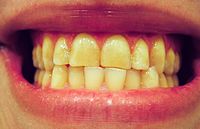
Photo from wikipedia
Sleep, and rapid eye movement (REM) sleep in particular, has been suggested to play an important role in mood regulation. Currently, most of this research has come from laboratory settings… Click to show full abstract
Sleep, and rapid eye movement (REM) sleep in particular, has been suggested to play an important role in mood regulation. Currently, most of this research has come from laboratory settings under constrained conditions; less is known about one’s sleep in their own home. The purpose of this study was to further examine the associations between home-based polysomnography (PSG) sleep parameters and mood disturbance. This cross-sectional study used baseline data from 120 inactive adults with desk-based jobs (52.5% female, 43.8±10.7 y) who were enrolled in an ongoing clinical trial. Mood was assessed using the Profile of Mood States (POMS); its 7 subscales (tension, anger, fatigue, depression, esteem-affect, vigor, confusion) were summed (with a constant of 100) to generate a Total Mood Disturbance (TMD) score with a higher score indicating greater TMD. Sleep stages were assessed after a full workday using one night of at-home PSG. Multiple linear regression models examined associations between sleep stages and mood adjusting for age, gender, and whether the assessment occurred pre- or post-COVID-19 emergence. The mean TMD score was 98.6±18.3. On average, participants slept for 397.4±60.0 minutes with a sleep efficiency of 84.6±9.1%. The mean percentage of time spent in REM sleep was 22.5±6.6%; the mean percentage of time spent in non-rapid eye movement (NREM) sleep, stage 1 (N1), stage 2 (N2), and stage 3 (N3) sleep were 7.8±5.0%, 53.7±10.1%, and 16.0±9.1%, respectively. A greater percentage of REM sleep was associated with lower TMD (β=-0.22, p=0.01). A greater percentage of N1 sleep was also associated with lower TMD (β=-0.23, p=0.01). However, neither percent of N2 nor N3 sleep were associated with TMD (p=0.10 and p=0.12, respectively). Overall, the findings of this study support current literature that suggests REM sleep plays a significant role in mood regulation. They also suggest, aside from N1 sleep, NREM sleep may not impact mood disturbance. In the future, the effects of sleep architecture on mood disturbance could further be explored through randomized controlled trials. This study was funded by National Institutes of Health (NIH) grants R01HL134809 and R01HL147610.
Journal Title: SLEEP
Year Published: 2023
Link to full text (if available)
Share on Social Media: Sign Up to like & get
recommendations!